How to Spot and Take Care of Your Baby’s Rash
Medically reviewed by Daniel Combs, MD
Many types of rashes can affect a baby’s skin on various parts of their bodies. Most rashes are uncomfortable but treatable. Other times, infant rashes can indicate a more serious illness that requires medical treatment.
Babies have sensitive skin that may be more likely to react to irritants and allergens than the skin of adults and older children. Knowing the potential causes of a rash may help determine if your little one needs treatment.
This article discusses the different types of baby rashes, how to treat them, and when to contact a healthcare provider.
What Does a Baby Rash Look Like?
Baby rashes vary in appearance based on the type, underlying cause, and location. Rashes often appear as irritated red and swollen skin. On lighter skin tones, they may appear red or pink. On darker skin tones, they may look white or gray.
Many types of rashes are made up of tiny bumps on the skin. Rashes may feel itchy and uncomfortable.
What Causes a Baby Rash?
A variety of factors can lead to infant rashes. Babies have sensitive skin and developing immune systems. This can lead them to experience rashes from factors including:
Infections
Irritants
Friction
Moisture
Heat
Fragrances
Laundry detergents
Learn More: Common Skin Rashes in Children
Common Types of Baby Rashes
Most infant rashes are relatively mild and can be treated at home. If your little one seems uncomfortable, call your child’s healthcare provider for further guidance.
Cradle Cap
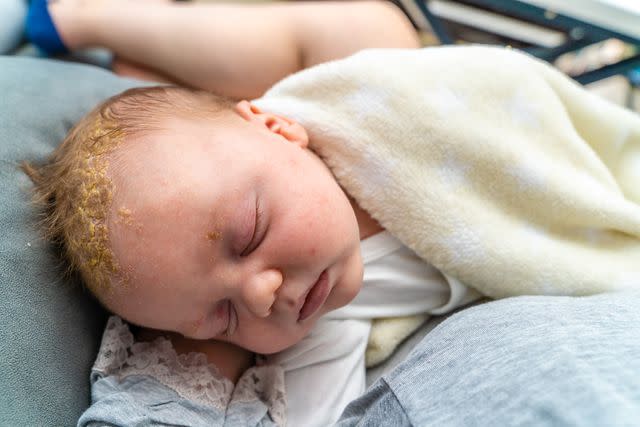
Media Trading Ltd / Getty Images
Cradle cap refers to a scalp, forehead, or face rash. It can also appear in the diaper area, skin folds, and underarms. Cradle cap looks like greasy, yellowish patches of skin that crust over. The skin may also look scaly or flaky.
Cradle cap is most common in children ages 2 weeks to 12 months. It usually resolves on its own. However, if cradle cap does not resolve on its own, your child’s healthcare provider may prescribe a mild steroid cream or antifungal shampoo.
Eczema
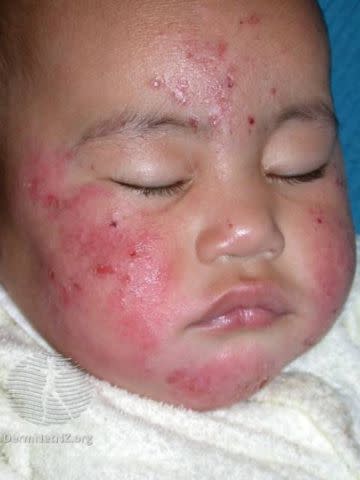
DermNet / CC BY-NC-ND
Eczema (atopic dermatitis) is a chronic skin condition affecting up to 25% of young children, and 60% of those affected develop it in their first year. One of the best ways to manage eczema is to avoid any irritants or allergens that cause it.
Treatment for eczema usually includes moisturizers and lifestyle changes. When your baby has eczema, they will likely need a short bath daily to remove any dirt or irritants from their skin. After the bath, apply a thick cream or ointment specially made for babies. Your child’s healthcare provider may also recommend topical corticosteroids.
Diaper Rash
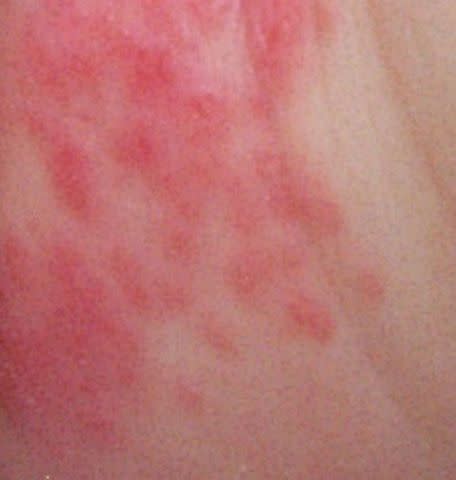
Reproduced with permission from ©DermNet NZ www.dermnetnz.org 2022.
Diaper rash is a common skin condition in babies that is usually caused by moisture. Common symptoms include skin redness, soreness, and peeling. Diaper rash can be quite uncomfortable for babies and may cause crying and fussiness.
Over-the-counter (OTC) creams that contain zinc oxide are usually an effective treatment for diaper rash because they provide an effective barrier between the skin and any moisture in the diaper.
Baby Acne
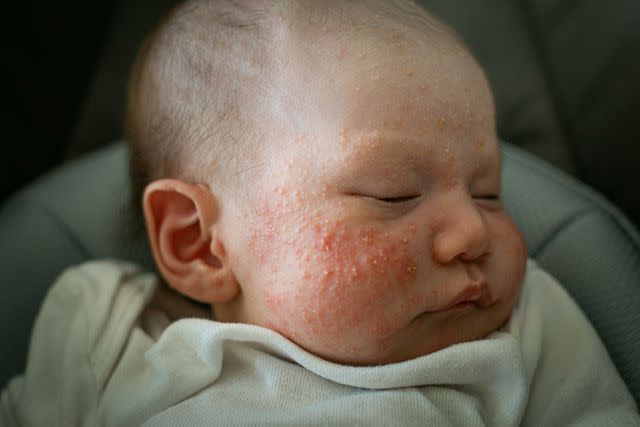
globalmoments / Getty Images
Up to 20% of newborns experience neonatal acne. Babies can be born with acne and develop it anytime before they are 6 weeks old. You may notice breakouts on your baby's cheeks, forehead, nose, chin, or scalp.
To care for your baby's skin, cleanse it with lukewarm water and avoid scrubbing. See your child's healthcare provider if your baby develops acne after 6 weeks of age.
Drool Rash
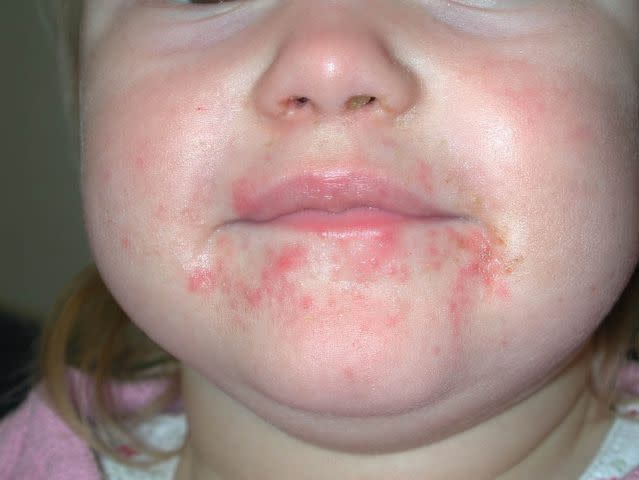
Reproduced with permission from © DermNet dermnetnz.org 2023.
Drool rash happens when a baby’s skin becomes irritated from contact with their saliva. Babies naturally drool because of teething and their developing salivary glands. You may notice skin irritation and redness on your baby’s chin, cheeks, neck, or chest.
To manage your child’s drool rash, use a warm washcloth to gently wipe drool or food away. Applying petroleum jelly or Aquaphor cream to protect their skin from moisture may also help.
Impetigo
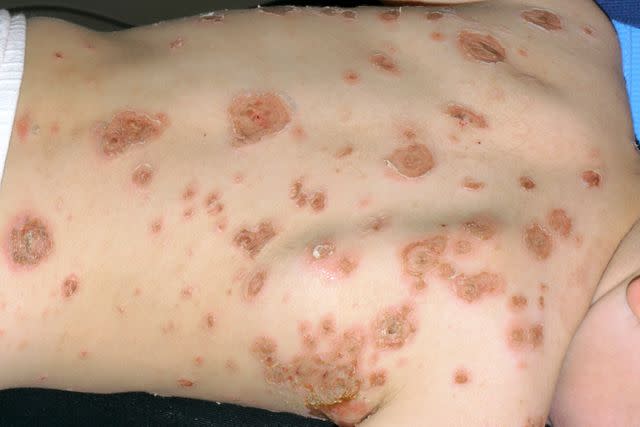
Reproduced with permission from © DermNet dermnetnz.org 2023.
Impetigo is a common bacterial infection in babies and young children and usually looks like open red sores. The sores leak clear fluid or pus for a few days, then crust over into honey-colored scabs.
Impetigo is a bacterial infection that requires antibiotic therapy. See your child’s healthcare provider for a topical or oral antibiotic prescription.
Fifth Disease
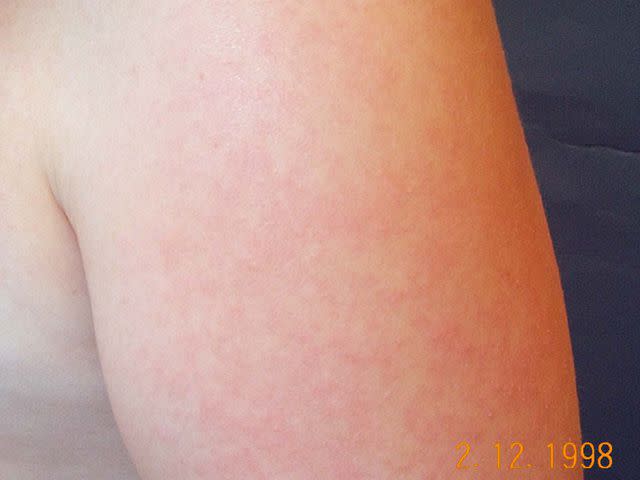
Reproduced with permission from © DermNet dermnetnz.org 2023
Fifth disease is a viral illness. In addition to a fever, headache, and runny nose, it often causes a bright red rash on the cheeks. After a few days, the rash may spread to the trunk, arms, and legs.
Home treatment usually includes rest and fluids. Your healthcare provider may recommend Tylenol (acetaminophen) for the fever.
Hand, Foot, and Mouth Disease
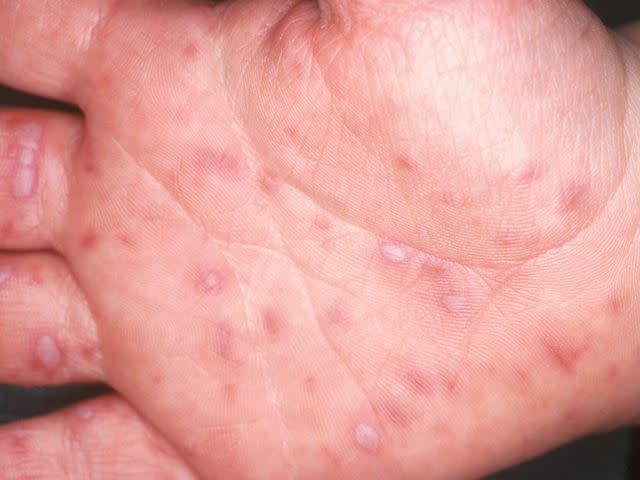
Reproduced with permission from © DermNet dermnetnz.org 2023
Hand, foot, and mouth disease is a common virus in children under age 5. It is very contagious but usually not serious. Most children feel better within seven to 10 days.
Hand, foot, and mouth disease symptoms may include a fever, mouth sores, and a red rash. Home treatment includes rest, hydration, and OTC medications to manage the fever.
Allergic Reactions
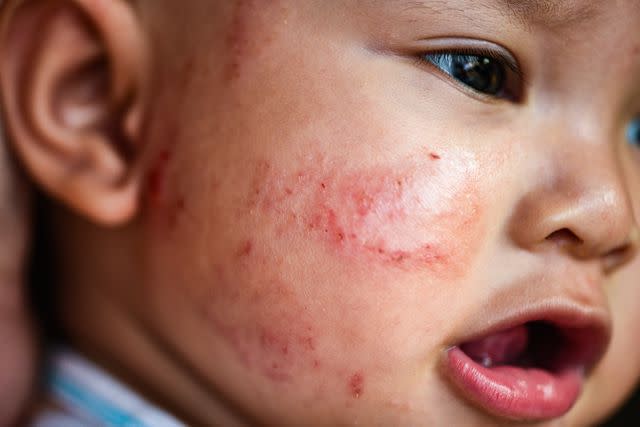
panida wijitpanya / Getty Images
Allergic reactions may lead to a skin rash and several other symptoms. A serious allergic reaction can cause itchy welts or skin bumps known as hives (urticaria). A reaction to certain foods, medications, or other irritants may cause this rash.
Contact dermatitis occurs when the skin comes in contact with something irritating, such as a chemical or fragrance. This rash may look like red blisters that burn or itch.
Heat Rash
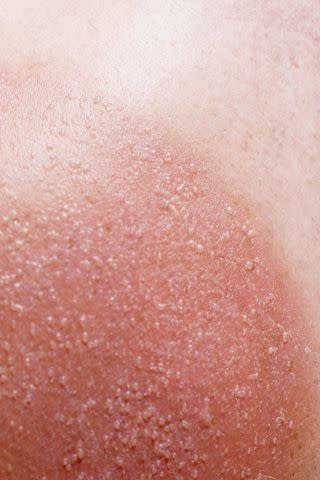
Heat rash occurs when the skin pores on the sweat glands get blocked and the body overheats, usually when it is very hot outside. You may notice that your baby’s skin has tiny red bumps or blisters. Move them to a cooler place and provide hydration.
Related: What a Heat Rash Looks Like on Darker Skin (and What to Do Next)
Chickenpox
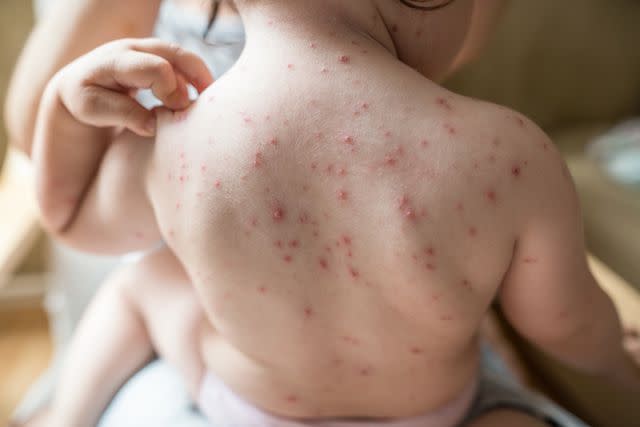
Mixmike / Getty Images
Chickenpox is a highly contagious disease that leads to an itchy, blister-like rash on the chest, back, face, and entire body. Chickenpox may be mild but can cause serious illness in infants younger than 12 months. Fortunately, chickenpox is preventable with a two-dose vaccine.
Measles
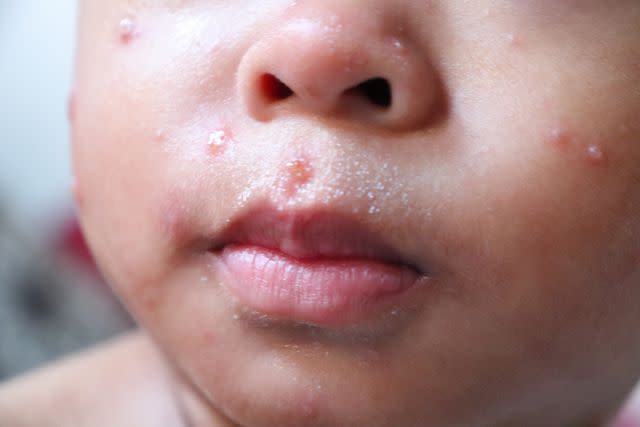
Rini Rezeki / Getty Images
Measles is a contagious virus that is serious, especially for newborns. Measles causes a high fever, cough, runny nose, watery eyes, and rash. The rash usually appears about three to five days after symptoms start. See your child’s healthcare provider if you believe that they could have measles or were exposed to it.
Measles is preventable with the measles vaccine. Talk with your child’s healthcare provider about vaccine schedules.
Thrush
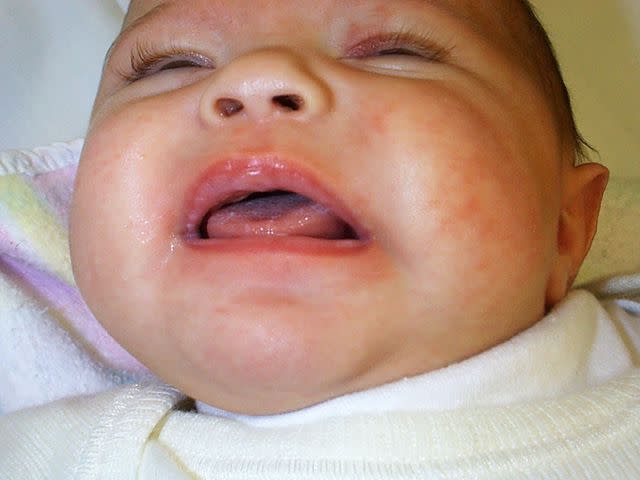
Reproduced with permission from © DermNet dermnetnz.org 2023.
Thrush is a yeast infection in babies, causing irritation in and around a baby’s mouth. Symptoms may include cracked skin in the corners of the mouth and white patches on the lips, tongue, and insides of the cheeks.
If you suspect that your baby has thrush, see your child’s healthcare provider for an antifungal treatment. Wash your baby’s pacifiers and bottles in hot water to kill fungi or bacteria and lower the risk. If you are breastfeeding and notice red sores on your nipples, talk with a healthcare provider to determine if you have thrush.
How to Prevent a Baby Rash
Infant rashes are common and cannot always be prevented. However, it is possible to lower the risk of skin irritation and rashes by:
Changing diapers frequently and as soon as they are soiled
Using a mild, fragrance-free baby soap
Limiting your baby’s baths to five to 10 minutes in warm (not hot) water
Applying fragrance-free baby lotion or cream
Keeping your baby’s skin clean and dry
Dressing your baby in breathable fabrics in hot weather
Keeping your child’s vaccinations and checkups up to date
Making sure your baby’s diaper fits well and is not too small or tight
When to Contact a Healthcare Provider
Call your healthcare provider when a rash lasts longer than a week or is spreading. Your child may need medical treatment if they experience a rash with any of the following symptoms:
Fever
Pain
Irritability
Lethargy (tiredness)
Swollen face
Trouble breathing
Stiff neck
Sensitivity to light
Summary
Babies commonly experience rashes on various parts of their bodies. Possible causes of baby rashes include infections, allergies, heat, friction, moisture, and irritants. Many types of rashes are uncomfortable but can be treated. Occasionally, a rash may indicate a baby has a serious medical condition or infection, such as meningitis.
To lower your child’s risk of a rash, change diapers frequently, use fragrance-free laundry detergent, and dress them in light, absorbent layers. See your child’s healthcare provider if they experience a rash with a high fever, pain, lethargy, fussiness, wheezing, swelling, trouble breathing, or a stiff neck.
Read the original article on Verywell Health.

